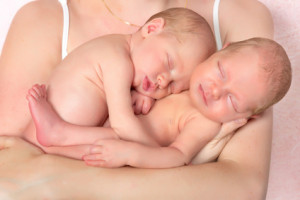France’s twin birth boom

The number of twin births in France has almost doubled in the last 40 years. Why? What are the effects? Twins are more fragile at birth than single-birth babies, resulting in excess mortality early in life. What is the figure? Nadège Couvert worked for several years as a doctoral student at INED and has just defended her doctoral thesis, in which she worked to answer some of the many questions raised by the demography of twins in France.
Early in the 21st century, 16 out of 1000 deliveries in France have been of two babies, meaning that slightly over 3 children in 100 are twins. The frequency of twin births has risen spectacularly-by over 80%-in the last 40 years.
A public health problem
Being born a twin is a health handicap, at least at the start of life. Twins weigh relatively little at birth, are frequently born prematurely, and there are often delivery complications, all of which means that twin mortality is much higher than mortality among single-birth babies. The recent increase in the frequency of twin births in France is actually slowing the fall in the country’s neonatal and infant mortality rates. The phenomenon is now perceived as a serious health problem, leading to a desire to know more about the demographic factors involved.
A variety of statistical sources
Contrary to Scandinavian and English-speaking countries, France has no distinct registry for twin births. But it does have various statistical sources: civil registries, INSEE’s on-going demographic sample, and various INSEE and INED Familles surveys. Analysing this data allows for answering several different questions: How many twins are born in France? How many die? Does excess mortality among infant twins extend beyond early childhood? Does twins’ behaviour when it comes to fertility, nuptiality, schooling, etc. differ from that of single-birth children? Do twin siblings resemble each other more in these behaviours than ordinary brothers and sisters?
Interaction between biology, medicine and society
The rate of twin births is sensitive to different factors, including mother’s age and children’s birth order. The average age of motherhood in France has evolved over the last 60 years: in the 1950s it was close to 28 years; it then fell regularly, reaching 26.5 years in 1977, before rising speedily to 30 years in the early 2010s. Twin birth trends are partially linked to variations in pregnancy spacing. Older women give birth to twins more often than younger women.
One-third of the spectacular rise of nearly 80% in twin-birth rates since the early 1970s is due to delaying motherhood. The other two-thirds are explained by fertility treatments (hormonal stimulation, assisted reproductive technology).
In reality, many factors impact on twin-birth rates, and they pertain to both biology and behaviour. Those rates are sensitive to different effects wherein biology, medicine and society all interact; they constitute a precious indicator of biological and social change.
Contact : Gilles Pison
Online : June 2011
